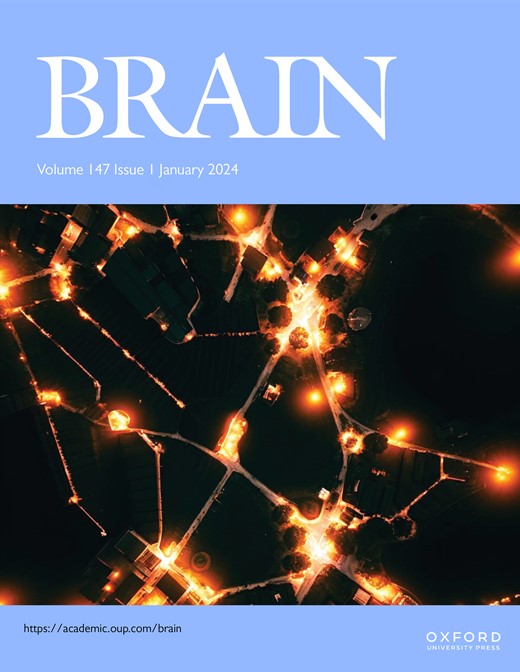额颞叶变性- tdp - c伴原发性进行性失语的萎缩进展
IF 11.7
1区 医学
Q1 CLINICAL NEUROLOGY
引用次数: 0
摘要
神经退行性疾病的临床病理相关性导致了对选择性易感性的神经生物学和认知网络解剖学的新见解。C型(TDP-C)交换反应DNA结合蛋白TDP-43 (FTLD-TDP)异常沉淀的额颞叶变性的神经病理实体是最独特的例子之一。TDP-C总是以局限于颞极区(TPR)的神经退行性变(萎缩)开始。该过程通常是不对称的,当主要是右侧时,会导致行为异常和联想失认症,当主要是左侧时,会导致语义性原发性进行性失语症(PPA),当双侧时,会导致语义性痴呆。在这项研究中,我们研究了不对称左TPR变性TDP-C患者萎缩进展与单词理解能力进行性溶解的关系。为了同质性起见,为了使用功能进展的共同标准,我们将重点放在左向不对称和最初孤立的语言障碍患者身上。利用24次结构MRI扫描的数据和命名、单词定义和单词与图片匹配的专门测试,我们根据名词表征受损的三个越来越高级的阶段对峰值退化部位进行了分层。根据这种发展模式,相对孤立的失范症的初始阶段之后是额外的类别内单词含义模糊,在更高级的阶段,是类别间模糊。基于体素的形态测量(VBM)灰质体积图进行二值化,以识别在每个阶段最频繁萎缩的区域。结果表明,词义的渐进式溶解与从初始阶段的左颞极皮层到后期更多的后梭状回、颞外侧和颞枕区萎缩的尾侧进展有关。通过精确表征单词理解障碍的阶段,而不是根据症状发作的估计时间,对进行性萎缩进行分层,提供了TDP-C的功能而不仅仅是时间上的进展解剖,并更清楚地了解了TPR成分与单词表征的认知映射之间的关系。本文章由计算机程序翻译,如有差异,请以英文原文为准。
Atrophy progression in frontotemporal lobar degeneration-TDP-C with primary progressive aphasia
Clinicopathologic correlations in neurodegenerative diseases have led to novel insights on the neurobiology of selective vulnerability and the anatomy of cognitive networks. The neuropathologic entity of frontotemporal lobar degeneration with abnormal precipitates of the transactive response DNA binding protein TDP-43 (FTLD-TDP) of type C (TDP-C) is one of the most distinctive examples. TDP-C invariably starts with neurodegeneration (atrophy) confined to the temporopolar regions (TPR). The process is usually asymmetric, causing behavioral abnormalities and associative agnosia when predominantly right-sided, semantic Primary Progressive Aphasia (PPA) when left-sided, and semantic dementia when bilateral. In this study, we investigated the relationship between atrophy progression and the progressive dissolution of word comprehension in TDP-C patients with asymmetric left TPR degeneration. For the sake of homogeneity, and in order to use a common yardstick of functional progression, we focused on patients with leftward asymmetry and initially isolated verbal impairment. Using data from 24 visits with structural MRI scans and specialized tests of naming, word definition, and word-to-picture matching, we stratified the anatomy of peak degeneration sites according to three increasingly more advanced stages of impaired noun representations. According to this pattern of progression, an initial stage of relatively isolated anomia is followed by additional intra-category blurring of word meaning and, at still more advanced stages, inter-category blurring. Voxel Based Morphometry (VBM) maps of gray matter volume were binarized to identify regions most frequently atrophied at each of these stages. Results illustrate that the progressive dissolution of word meaning is associated with caudal progression of atrophy from the left temporopolar cortex at initial stages to more posterior fusiform, lateral temporal and temporooccipital regions in later stages. The stratification of progressive atrophy by precisely characterized stages of word comprehension impairment, rather than by estimated time of symptom onset, offers a functional rather than just chronological anatomy of progression for TDP-C and a clearer view of the relationship between TPR components and the cognitive mapping of word representations.
求助全文
通过发布文献求助,成功后即可免费获取论文全文。
去求助
来源期刊

Brain
医学-临床神经学
CiteScore
20.30
自引率
4.10%
发文量
458
审稿时长
3-6 weeks
期刊介绍:
Brain, a journal focused on clinical neurology and translational neuroscience, has been publishing landmark papers since 1878. The journal aims to expand its scope by including studies that shed light on disease mechanisms and conducting innovative clinical trials for brain disorders. With a wide range of topics covered, the Editorial Board represents the international readership and diverse coverage of the journal. Accepted articles are promptly posted online, typically within a few weeks of acceptance. As of 2022, Brain holds an impressive impact factor of 14.5, according to the Journal Citation Reports.
 求助内容:
求助内容: 应助结果提醒方式:
应助结果提醒方式:


